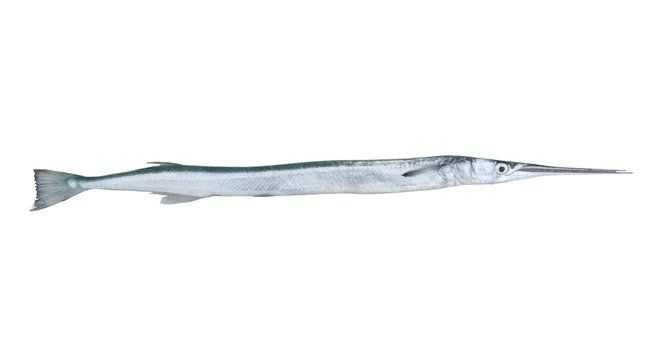Houndfish

Species Details
Tylosurus Crocodilus
Belonidae
Beloniformes
Lagoons, Seaward Reefs
1 - 14 lbs.
12" - 60"
Houndfish (Tylosurus Crocodilus) Fish Description
Where did the Houndfish get its name? It certainly doesn’t look like a hound! The Houndfish is a serpentine fish. It’s quite long and has a long snout in the shape of a needle. Hence, its other name – the Crocodile Needlefish. It has a stout body that appears cylindrical and a shorter head than most needlefishes. Its snout however makes up for the length.
Color-wise, the Houndfish is dark blue with silver-white sides. The rest of them is a plain white color. The Houndfish also has a distinct feature. It has a keel on its caudal peduncle and its tail fin is deeply forked. Its dorsal fin is much closer to the tail fin and runs parallel to the anal fin.
While young, the Houndfish’s’ teeth usually are pointing forward whereas others have them pointing straight.
Houndfish Diet and Size
Houndfishes, since they like remaining near the surface, usually feast on small fishes. They like feasting on small flying fishes since they’re quite the magnificent leapers themselves. Their fish of choice however is anchovy.
Houndfishes are considered the biggest in the Belonidae family. They can grow up to a whopping 5ft and weigh up to 14 lbs. However, their average weight is around 10 lbs.
Interesting Facts about the Houndfish
- Although considered a gamefish, Houndfishes scare anglers. Anglers are not terrified by them being carnivorous. Rather, it’s their ability to leap.
- The Houndfish’s size and needlenose makes them look intimidating. It doesn’t help that they have a tendency also to leap high into the air.
- Houndfish are okay with traveling solo or in groups.
- The eggs of a Houndfish have tendrils which are how they can attach to the seaweed.
- Houndfish are like moths. They are attracted to lights.
- Most wounds inflected by a Houndfish are not via bites. It’s via puncture wounds!
- Houndfish are usually preyed on by bigger fishes such as tunas.
- Houndfish are easily frightened.
Houndfish – Fishing Techniques: How to Fish for a Houndfish
When catching a Houndfish, you’re not supposed to reel it in right away.
As an easily agitated fish, let the Houndfish tire itself out first. They’ll be jumping around so you might want to keep your distance unless you want to end up full of holes. Most anglers usually bide their time when catching these Houndfish so that there’ll be less risk to account for.
In terms of equipment, light tackle will do. Since the Houndfish is pelagic – meaning it prefers staying near the surface, you won’t need heavy-duty equipment. Usually, heavy-duty equipment is for deep-dwelling fishes or sharks. Or even in some cases, marlins since they’re fierce fighters and they can drag you down if you’re not careful. Hook-wise, the recommended hook for the Houndfish is the tail hook. What makes it hard to catch them is not their flighty nature but rather how small their beak is. Sometimes, Houndfish can devour the bait without even getting snagged. As an angler, your best option is to give it a quick jerk that will snag the hook onto its vomer or at least part of its beak.
For bait, anchovies will definitely do the trick. Small fishes are its preferred food but anchovies will get them coming. Anchovies can be quite smelly which will get them running to you.
Houndfish Habitat and Distribution
Houndfishes usually appear near jetties, piers and, reefs especially during breeding time. They usually breed around April and May. That’s the best time to catch them as they’ll all be clumped up into one spot.
As for when to catch them, there’s been no significant difference between day and night.
Houndfish also like lagoons and seaward reefs. Here, they find their daily meal of small fishes. Or, if you catch them between April and May they may be laying their eggs there. They also like remaining near the surface but not too much by the coastlines.






